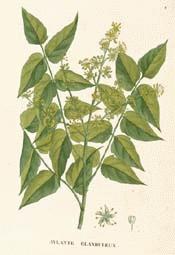
Botanical.com Home Page

|
Swingle, Tree of Heaven
(Ailanthus altissima Miller)
Click on graphic for larger image
|
Tree of Heaven
Botanical: Ailanthus glandulosa (DESF.)
Family: N.O. Simarubeae
---Synonyms---Chinese Sumach. Vernis de Japon. Ailanto. (Trans. as Tree of the Gods. - Götterbaum.).
---Parts Used---Inner bark of tree, root.
---Habitat---China and India. Cuitivated throughout Europe and the United States.
---Description---A large, handsome tree of rapid growth, bearing leaves from 1 to 2 feet long, and greenish flowers of a disagreeable odour. Was introduced into England in 1751 and is frequently found in gardens as a shade tree.
The Ailanthus imberiflora occurs in Australia, and in India the A. excelsa has a bark used as a bitter tonic.
In France it is cultivated for its leaves, on which the caterpillar of the silk-spinning Ailanthus Moth (Bombyx Cynthia) is fed, yielding a silk more durable and cheaper than Mulberry silk, though inferior to it in fineness and gloss. Its name of Japan Varnish shows that it was mistaken for the true Japanese Varnish Tree, a species of Sumach. At one time it was classed as a Rhus.
The wood is satiny, yellowish-white, and well suited for cabinet-making when climates permit of adequate growth.
The bark has a nauseating, bitter taste, and, when fresh, a sickening odour.
The leaves have been found in commerce adulterated with those of senna.
---Constituents---Lignin, chlorophyll, a yellow colouring matter, a gelatinous substance (pectin), quassin, an odorous resin, traces of a volatile oil, a nitrogenous, fatty matter, and several salts. A later analysis found starch, tannin, albumen, gum, sugar, oleoresin, and a trace of volatile oil, potash, phosphoric acid, sulphuric acid, iron, lime, and magnesia.
All the characteristic properties of eitherthe fresh or carefully dried bark can be exhausted by alcohol, to which a deep, green colour will be imparted, changing to yellowish-brown with age and more quickly if exposed to air.
[Top]
---Medicinal Action and Uses---Antispasmodic, cardiac depressant, astringent. The effect produced by Hetet when experimenting on dogs, was copious stools and the discharge of worms. The resin purges, but rarely acts as an anthelmintic. In China the bark is popular for dysentery and other bowel complaints. A smaller dose of the oleoresin produces similar results, and keeps better than the bark.
The vapours of the evaporating extract have a prostrating effect, as have the emanations from the blossoms, while the action upon patients of powder or extract is disagreeable and nauseating, though they have been successfully used in dysentery and diarrhoea, gonorrhoea, leucorrhoea, prolapsus ani, etc., and also as a taenifuge.
The infusion may be given in sweetened orange-flower or other aromatic water, to lessen the bitterness and resultant sickness. Though it produces vomiting and great relaxation, it is stated not to be poisonous.
A tincture of the root-bark has been used successfully in cardiac palpitation, asthma and epilepsy.
The action of the trees in malarial districts is considered to resemble that of the Eucalyptus.
The statement that the resin is purgative has been disputed, some asserting that it is inert.
---Dosages---From 7 to 20 grains. Of the tincture, 5 to 60 drops from two to four times aday. Of the infusion, a teaspoonful, night and morning, cold. (50 grams of the rootbark infused for a short time in 75 grams of hot water, then strained.)
[Top]
Common Name Index
A MODERN HERBAL Home Page
Bear in mind "A Modern Herbal" was written with the conventional wisdom of the early 1900's. This should be taken into account as some of the information may now be considered inaccurate, or not in accordance with modern medicine.
© Copyright Protected 1995-2025 Botanical.com
|

